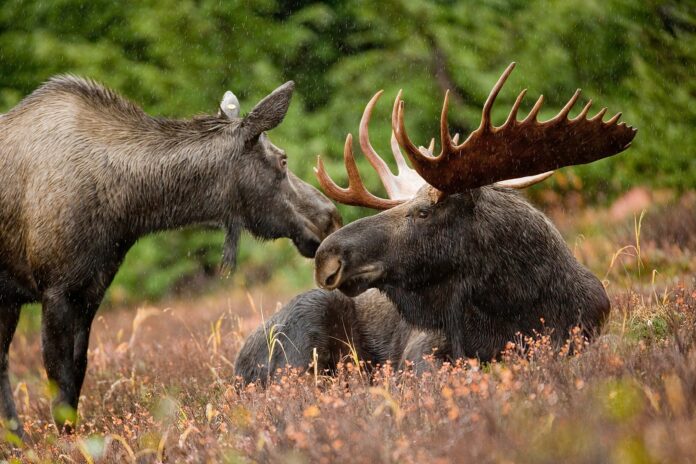By HARRY WEEKES
I pulled out of school and headed north up Aviation Drive. It was dark, with the usual background city lights. When a car turned toward me, my first thought was, “Who put a giant cardboard cutout of a moose in the middle of the road?” About halfway between me and this car was a perfect silhouette of a moose—jet black, more an inky absence of light, as though the very animal was absorbing it. It was all moose. Comically long legs. A bulging snout. Knobs all over its head. And those great, twitchy ears.
By the time I reached the spot, the animal was standing in front of Sun Valley Storage, casually looking over its shoulder as if deciding where to go.
I’ve had a particularly moose-y couple of weeks. The above silhouette. Then, two mornings later a teacher asked me if I’d seen the big moose outside, nibbling on our crabapple trees. Then, there was the moose just kind of sauntering down Indian Creek Road one night that casually stepped over what seemed to be a 4-foot-tall snowbank as it moved out of our way.
How something so big seems to just appear—and disappear—is very interesting to me, as much as the peculiar things the moose I see do. I could understand something that comes and goes, leaving no trace. But to set up camp in your yard and eat your crabapples? Or to walk the same path as you near the Bow Bridge and leave piles of telltale deer scat (moose and deer are in the same family—Cervidae). Or to walk up the road to my in-laws’ house, totally exposed, then have one of your kids lick the window of my car. Now that’s weird. Weird in a good way.
Moose are that giant enigma. When I am lucky enough to see one with friends not from here, they are astonished. While I recognize moose immediately—they are bigger than horses, after all—and there is a kind of familiarity in them, they also come with a curious distance, almost like they are some kind of walking tree. This distance is present in big things—whales, elephants, bison. As if, somehow, their size is linked to an ancient wisdom, a patience, I don’t fully understand.
This is captured most acutely in the eyes—large, watery, blinking infrequently. It seems the animal is taking in the world, one it doesn’t fully understand. Or, perhaps more accurately, one I don’t understand. Invariably, I wonder about them in human terms: Why are you in the middle of the road? Why not just stay on the road? Are you the same moose? The same family?
How much harder is it to even conceive of thinking of their world as they do? What questions does a moose ask? Does a moose have an inner voice? Or do they think in images? It is hard for me even to fabricate a moose question that sounds like something a moose would ask.
Maybe that deep look, that ancient understanding, is some kind of bedrock patience, simply waiting for me to catch up. Like the moose itself, this big idea comes along and, as quickly, disappears into the willows of my mind—a shadow, with some promise that I will encounter it again. Maybe next time, I will get it.
Harry Weekes is the founder and head of school at The Sage School in Hailey. This is his 49th year in the Wood River Valley, where he lives with Hilary and two of their three baby adults—Penelope and Simon. The other member of the flock, Georgia, is currently fledging at Davidson College in North Carolina.



